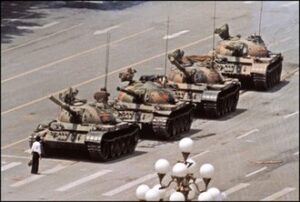
The “Tank Man” photograph is a piece of protest art that was taken in the 1990s that I find to be a historical piece of protest art. This photograph stood for the significance of what a singular person can accomplish in a protest, especially as someone who stood for his rights against the Chinese military’s orders by simply blocking their way in killing more civilians. This is proven in the photograph, as shown with the man having no weapons or any political status standing in front a huge row of tanks, even knowing the legal consequences he could face with the tank’s potential in eliminating him. This photograph captures the tension of that scenery when Deng Xiaoping initially carried out his execution orders through the numerous civil opposition that was against the Chinese Community Party’s political philosophy at that time.
It’s such a historical piece of art because there are very few pieces of art that have been captured of the Tiananmen Square Massacre, as a result of the Chinese government censoring and even removing any records that people have kept of this tragic event. It’s been heavily talked about in class about how historical art is a very important treasure in highlighting an artist’s mood and message, when he/she captures a particular historical event in his/her own perspective. The Deng Xiaoping administration wanted to destroy any evidence of the Tiananmen Square Massacre event occurring by targeting an enemy that was so large at that time: The media. Even with many of the photographs wiped from the reporters’ devices, many photographs and other forms of art (Eyewitness testimonies) still exist to shine light to the rest of the world of this tragic Chinese event in history. Although dictatorship had a profound effect on the Chinese citizens who’ve been forced to be silent after the event, I find it fascinating that there are still artists present that find ways to protect their form of art in an effort to get their voices heard.


